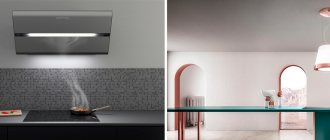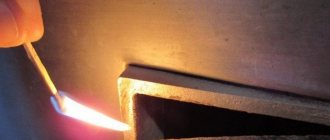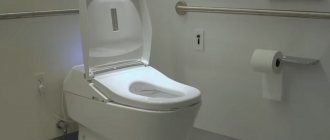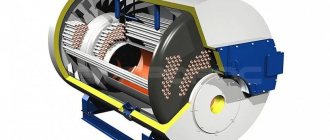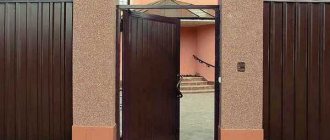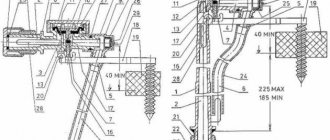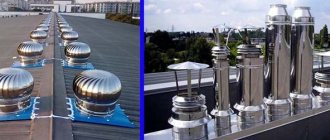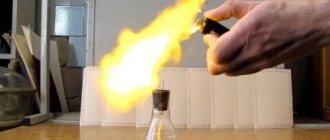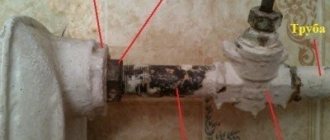During cooking, the air in the kitchen becomes humid from evaporating liquids, and at the same time it is saturated with various odors, grease, etc. In order to avoid the spread of this air throughout all living spaces, ventilation is provided in the kitchen. In apartment buildings, it works on the extraction principle, preventing odors from one apartment from entering the neighboring one.
The draft in the ventilation shafts is not too strong, so as not to create noise and drafts in the apartments. And if this is enough to eliminate humid air from the bathroom, it is difficult to remove odors, steam, and sometimes even smoke from cooking in the kitchen. To solve this problem, additional hoods installed directly above the stove or hob began to be used everywhere.
Description of the operating principle of the hood
The operating principle of this device is quite simple. The design is based on an engine with an impeller, during operation of which air flows move. The system is reminiscent of a vacuum cleaner, only instead of a narrow air intake pipe, a wide dome is used, covering the entire cooking surface. The air that is drawn into the hood through a special channel is discharged into the ventilation system.
Previously, hoods were dome-shaped, did not have any cleaning systems and were quite noisy with low efficiency. Modern hoods are a whole work of art. They can not only remove unpleasant odors, but also decorate the kitchen space. Also, modern hoods use filtration systems, a work area lighting system, and many other useful functions.
Eating deliciously but having trouble breathing?
No matter how tasty the prepared dinner is, the air in the kitchen is not filled with mountain purity.
So, at lunchtime it’s time to turn on the hood: it helps remove a cocktail of harmful compounds and unpleasant odors from the air.
Save the cook: turn on the hood at the same time as the hob, oven, and countertop appliances: steamers, grills, deep fryers, toasters. The speed of the motor is set based on the intensity of the evaporation.
It includes formaldehyde, acrolein, amines, ammonia, benzopyrene, coronene, perylene, chrysene and others. These compounds are formed as a result of heating foods and various transformations that occur during frying, boiling and baking.
When using gas burners, carbon dioxide, sulfur and nitrogen dioxide, carbon monoxide, soot, and radon are added to this bouquet.
What is the difference between inclined hoods?
Inclined hoods are distinguished by the fact that, unlike dome hoods installed parallel to the slab, they are located at an angle of about 60 degrees. Thus, without hanging over the user and creating a feeling of free space. Technically, they are not much different from ordinary horizontal ones. To remove air, an electric motor is still used, thanks to which the air is discharged into the ventilation system. But thanks to this arrangement of the dome, as well as thanks to the perimeter suction system, the performance of this hood increases by 20-30%.
Kitchen ventilation system: requirements, features, arrangement rules
The design of ventilation and exhaust systems for kitchen premises is, in fact, very simple. There are many nuances, ignoring which we have every chance of creating incorrect and ineffective ventilation. Ventilation, which, instead of purifying the air, will literally poison our lives.
Natural kitchen ventilation and the law of conservation of air volume
Long gone are the days when residents of private houses and city apartments were satisfied with a natural ventilation system in the kitchen. Despite the relatively low efficiency of such systems (especially during cooking), the principles of their arrangement will always be relevant. The fact is that the continuous functioning of natural ventilation is possible only if certain conditions are met. Namely: ventilation ducts must ensure unhindered removal of air masses from the room, and the flow of fresh air into the kitchen must be continuous.
Effective operation of the ventilation system is only possible when the volume of air leaving the room is equal to the volume of air entering the kitchen.
What to put in for air flow in the kitchen
Compliance with the first condition can be ensured by timely cleaning and maintenance of ventilation ducts. The simplest supply valve to the kitchen as part of the ventilation system will help to fulfill the second condition.
BelkaFORUMHOUSE user
You can always embed a supply valve into the wall, which will enhance natural ventilation.
Just a couple of decades ago, most homes were equipped with wooden windows. Their tightness, as we know, left much to be desired. Therefore, the question of forced ventilation did not arise: the flow of fresh air into an apartment or house occurred practically without human intervention. Today, when we are dealing with sealed double-glazed windows and powerful kitchen hoods, a supply ventilation valve built into the design of a plastic window or mounted in a wall is not a whim, but a necessity.
The simplest do-it-yourself supply and exhaust ventilation
If your house or apartment has a natural ventilation system with an exhaust vent in the kitchen, then you are practically not in danger of smelling cakes in the bedroom. If your house is just being built, then it’s time to take care of having such a system. Operating in normal mode, it will constantly refresh the air in the kitchen area, and if its efficiency is insufficient, it can always be improved by equipping it with a small exhaust fan.
If you live in a private house, then a roof fan installed in the ventilation duct will help modernize the design of the system without creating noise during operation.
Andrey Vasiliev,
User FORUMHOUSE, Moscow - Rostov Veliky
If it is a private house, then the problem can be solved simply by installing a roof fan. Set it up and let it make noise outside.
If you live in an apartment, then a fan installed in the ventilation hole will qualitatively improve the flow of fresh air into the room.
HelFORUMHOUSE user
When I turn on a regular fan built into the vent in the kitchen, even with the door open, the smell goes into the vent.
A good solution could be a duct fan that can significantly increase the power of the exhaust flow.
By installing the listed devices, you can turn natural ventilation into a simple supply and exhaust system with your own hands.
Rules for creating air ducts
A natural ventilation system that does not have auxiliary fans can play a cruel joke on you at any time. We are talking about such a physical phenomenon as “overturning the thrust”. It is observed when, under the influence of external factors, the exhaust flow loses strength or completely changes its direction (air from the street begins to enter the room through the ventilation shaft). Therefore, it is advisable to place the ventilation duct on the roof, and its height should exceed the height of the ridge. This requirement is relevant both for natural ventilation and for the “forced ventilation” system in the kitchen.
MatildaFORUMHOUSE user
Traction overturning often happens in the off-season, when it is humid and chilly outside. If the ventilation pipe is installed below the ridge, then overturning will become a constant phenomenon and will depend on the direction of the wind.
The pipe and ductwork that will pass through cold areas (the attic and the outside of the building) should be insulated.
A ventilation duct led outside through an ordinary horizontal hole in the wall, due to the absence of a pressure difference inside and outside the building, will perform its function only when the fan is turned on.
Ventilation in the kitchen with a hood
We examined the features of systems that operate continuously and are designed to ensure effective air exchange in the kitchen. Now let's talk about kitchen hoods - devices that come into operation during the hottest hours, forcibly helping us get rid of the smell of food cooking on the stove.
A kitchen hood, unlike a standard ventilation system, helps capture smoke, steam and grease particles that enter the air during cooking. Therefore, the requirement to install an exhaust device in addition to the existing ventilation system is justified.
Arsenal&NatalyaFORUMHOUSE user
A hood is needed if you don’t want to do frequent renovations in the kitchen. There are no miracles, and without forced removal of evaporation products to the outside, they settle on walls, ceilings, furniture and people.
You need a hood in the kitchen, let's think about what kind of hood to make.
According to the principle of operation, hoods are divided into two types - flow and recirculation. Flow-through systems remove air from the room to the street, while recirculation systems filter out impurities and supply air back into the room.
It is clear that recirculation exhaust devices are not popular among users of our portal. And there are several reasons for this: the need to frequently replace the filter, low efficiency and the inability to remove excess heat from the room.
Andrey Vasiliev
Such a hood is of little use (in my house it’s only there because I’m too lazy to pull a pipe to the duct). Grease quickly accumulates on the walls and is very difficult to wash off (especially if the house is decorated with wood). If you are concerned about installing a hood, which is very useful (especially if you like fried fish, meat and other grills), then you need to vent it into the ventilation duct (I just don’t recommend going outside through the wall, because the wall will get dirty over time).
Considering all the disadvantages of recirculation units, they should be used only in exceptional, special cases.
A flow hood removes by-products formed during cooking outside the room. According to the installation method, flow hoods are suspended, built-in, corner, dome and island. Regardless of what type of installation the hood is, the removal of air from the room must be organized according to the same principle. It lies in the fact that the existing hood must be connected only to a separate ventilation duct.
It is prohibited to connect the hood to a common ventilation duct, and even more so to a chimney! In this case, carbon monoxide and exhaust air can flow back into the room.
Matilda
The hood from a kitchen gas stove should never be connected to anything. And the air duct from the stove should go vertically upward.
In houses with outdated types of ventilation systems, there is no insulated duct for connecting the hood. And since it is impossible to vent the hood into a common ventilation shaft, an additional ventilation duct must be made in a separate order. A suitable but ineffective solution in this case would be to purchase a recirculation unit.
If you are not afraid of ruining the facade of your house (apartment) with stains from grease, soot and steam, then you can make a separate horizontal channel in the wall for the hood. The outlet vent will be located directly on the outside surface of the wall. It is advisable to equip such a ventilation device in the kitchen at home with a check valve (if its presence is not provided for in the design of the hood itself) or an inertial grille.
shmendelForumHouse User
A motorized valve is good, but range hoods have check valves. All that remains is to ensure that air is not blown directly into the air duct.
Inertial grilles or deflectors will help to accomplish this “reducing ventilation in the wall in the kitchen.”
Ideally, the exhaust duct should be created according to the same principles by which other ventilation ducts are created. Namely: in order for the air duct to provide natural draft when the hood is turned off, it should be placed on the roof of the house (just above the ridge).
Particular attention should be paid to insulating the air duct in the attic and outside, which will prevent the formation of condensation.
Matilda
The air ducts that you will lay through the attic are wrapped in cotton wool.
About ventilation outlets: it is advisable to purchase ready-made products that, in accordance with existing standards, are insulated at the manufacturing stage.
Kitchen ventilation rules. Duct material
The material of the air duct used to connect the kitchen hood must meet the following conditions:
- Create minimal resistance to air flow;
- Have high anti-corrosion resistance;
- Have sufficient internal cross-sectional area.
Taking into account the first condition, a flexible corrugated pipe, the walls of which have a fairly high resistance, is recommended to be used exclusively for connecting the hood to the ventilation duct.
If possible, it is preferable to replace the corrugation with a smooth galvanized pipe of round or square cross-section.
To prevent rust from destroying the air duct, many people seek to introduce plastic sewer pipes with a thick cross-section into its design. But this material tends to accumulate fat deposits, but such pipes cannot be called safe. Their use can lead to a fire (as soon as the oil ignites in a hot frying pan while the hood is running). It is for this reason that the use of sewer pipes should be abandoned in advance.
Matilda
Under no circumstances should plastic be used for stove hoods. Even aluminum is not allowed. Galvanized or stainless steel only.
Here's what our users say about the cross-section of pipes designed to create ventilation ducts.
Smart2305FORUMHOUSE user
For hoods the connection is 150 mm. The diameter of the pipe along the riser should be 200 mm (choose the square equivalent yourself).
Requirements for exhaust ventilation in the kitchen. Power calculation
When choosing a hood for our own kitchen, each of us thinks about how much power this device should have. In all cases, this indicator depends on the area of the kitchen space. If the area of your kitchen is less than 10 m² (inclusive), and the height is 2.5 - 2.7 m, then a hood that passes through 280-350 m³ of air in one hour may well satisfy your needs. If the kitchen area is larger, then the power of the device should be appropriate.
In principle, this parameter can be obtained from sellers, or you can calculate it yourself using the formula: V=S*H*10*1.3. In it: S and H are the area and height of the room, V is the volume (m³/h).
You can learn about the general principles of creating ventilation systems in a private home, as well as get comprehensive information about the features of ventilation of rooms with high humidity, by reading a couple of useful articles posted on the FORUMHOUSE portal. If you are interested in the principles of arranging ventilation systems in kitchen areas, if you have practical experience, and you are eager to share your experiences in this area, then visit the relevant topic, where you can find a lot of interesting things for yourself. A video about the installation of supply and exhaust ventilation with a recuperator will help you solve questions that for some reason you could not find answers to after reading the previous materials.
Perimeter air suction
Perimeter suction is a type of air intake in which evaporation is drawn not in the center of the dome, but through special holes along its perimeter. Depending on the model and brand of the device, these air intakes can be designed differently. The most common today are hoods in which these gaps are formed thanks to a special plate-lid that covers the grease filter but does not fit tightly. Air is drawn in around the perimeter of this cover.
Devices of this type do not require the width of the hob to match the hood itself, which is quite convenient when designing a kitchen and when choosing appliances. The advantages of this type of air purifier design include significant energy savings. Due to the fact that air flows are sucked in evenly over the entire surface of the hood, the motor does not need to use its entire power reserve.
Hoods and accessories: where to buy?
When using a hood in recirculation mode, it is very important to promptly replace the carbon filters. Different brands use different types of these components. Knowing the brand and model of your air purifier, you can easily order carbon filters for home delivery. It is most profitable to purchase replacement parts in online stores, since they can offer the most affordable prices.
Those who are accustomed to fast delivery and affordable prices can turn to the Falmec online hood store, which contains the most popular models of air purifiers.
Accessories and replacement parts are collected in a separate section to make it easier for visitors to find the necessary components. Leave your tips and comments below. Subscribe to our newsletter. Good luck to you and good luck to your family!
Operation in air exhaust and recirculation mode (grease and carbon filters)
Most modern inclined hoods can operate in air exhaust and recirculation modes. The air exhaust mode is the normal operation of the device in which the entire flow is directed from the hob into the ventilation. To prevent liquid evaporated during cooking from entering the ventilation system, a grease filter is used. It is usually made of several layers of aluminum mesh. This filter is installed directly at the inlet, so it is the first thing that gets in the way of the sucked vapors.
This type of hood also uses a carbon filter. Its elements are made of activated carbon, which is a good adsorbent. When passing through this filter, unpleasant odors and harmful substances are absorbed by carbon and at the output we have purified air. Thanks to the use of two filters, it became possible to recirculate, that is, when the air passing through the hood is filtered, returning clean and harmless. This mode is economical and almost silent.
How to care for your hood?
Caring for the hood is not difficult. If dirt appears on the body, it can be easily removed with a soft sponge or cloth with a small amount of detergent. It is not recommended to pour copious amounts of water on the device or use household chemicals containing abrasive particles: the case may be scratched.
Hood care
While cleaning the housing, it is recommended to completely disconnect the air purifier. To do this, just turn it off and remove the plug from the socket. It is recommended to position the outlet itself in such a way that the device wire does not overheat while the stove is operating.
I recommend: What is rokhlya
Powerful Krona hoods
The Krona range of hoods is distinguished by a variety of shapes and design solutions. Various hoods use both classic and innovative solutions. The visitor can choose from the company's dome, island, inclined, suspended or T-shaped models. An excellent solution is also to choose a built-in cabinet model, which can suit a wide variety of interiors. The performance of the models can reach 1200 cubic meters of air per hour, and the number of motor speeds can be 5. Touch panels, classic buttons or convenient sliders can be used to control operating modes. The Krona brand equipment itself is a real work of art. In addition to high reliability and functionality, this technique amazes with its elegant design. By choosing Krona devices you will significantly improve the aesthetic appearance of the room, which will delight you every day.
Why does the hood stop working?
This happens for several reasons:
- The decorative grill covering the channel opening is dirty . This is the simplest option - you can solve the problem on the spot by removing the grille and cleaning it of soot and dust;
- Clogged ventilation duct . The air duct may become clogged with debris and accumulated dust. In winter, an ice build-up may form in it, preventing the outflow of air. Cleaning of the ventilation duct should be carried out by specialists of the management company;
- Dismantling of part of the air main by one or more residents. As a rule, the goal of apartment owners in this case is to increase living space. Such actions are illegal. In such a situation, it is necessary to draw up a collective complaint to the supervisory authorities.
How is the supply ventilation unit installed and connected?
The first stage is determining the installation location. The breather can be installed at any point on the wall (the main thing is that it faces the street). Most often, the device is mounted on the side of the window or under the windowsill. The choice of location is simplified by the compact dimensions of the internal unit (Tion Breezer Lite has only 26*26*13 cm) - this is less than a standard sheet of A4 paper.
The second stage is drilling a through channel in the wall. For this purpose, a modern diamond drilling installation is used, which allows even complete repair work to be completed - quickly, without dirt and dust.
After the channel is ready, it is thermally insulated and soundproofed using special materials. A protective grill is installed on the street side to prevent insects and debris from entering the channel. Then the device is fixed on the wall and connected to the air duct. Connection to the electrical network is made using a regular outlet.
How to organize work and calculate the system
It is necessary to calculate the diameter of the duct based on the volume of air in the kitchen.
It is possible to arrange a ventilation duct in the kitchen with the possibility of maintaining natural ventilation when installing a hood as follows:
- The working diameter of the mounted air ducts is determined. The size of the fan is taken into account; it exceeds the shaft dimensions by 10-15 cm.
- The performance of the system is determined, which is sufficient to service the premises. It is calculated as the product of the length, width and height of the kitchen minus the volume occupied by furniture and other surrounding objects.
- The resulting figure is multiplied by 6 and again by 12. The result is the desired indicator of system performance.
During installation, you should avoid the common mistake associated with blocking the ventilation opening with an exhaust pipe with an outlet into the ventilation. It is possible to increase the efficiency of the complex if there is an influx of fresh air into the room.
What to choose: hood or fan
To choose the right model for kitchen ventilation, you need to consider the following parameters:
- Performance. According to building and sanitary standards, the exhaust system in the kitchen must support a tenfold replacement of the air available in the room. This means that the total replacement volume must exceed the cubic capacity of the kitchen by 10 times. You also need to add 30% just in case. The result will be the required power that suits a specific kitchen. The quality of natural ventilation draft also influences the determination of performance. If its level is high, low-power models are also suitable, but in case of insufficient traction, an option with higher performance is needed.
- Noise level. The optimal level here is 35 dB, which is slightly higher than a whisper (30 dB). The noise directly depends on the fan power. The quiet option is suitable for the kitchen.
- Terms of Use. If the fan is located in the hood above the stove, it needs reliable protection from high temperatures. Many units are coated with heat-resistant compounds.
- Additional features. Some hoods, in addition to their direct function, are also supplemented with programmable timers, human presence sensors and other options that significantly increase ease of use.
Remember that any additional functions increase the cost of the equipment and reduce the duration of its trouble-free operation.
When choosing a hood, consider its design so that it looks harmonious and beautiful in the interior.
Can a range hood decorate the kitchen? Of course, as long as it is chosen wisely and looks impeccable and stylish!
Influence of external factors
And also, do not forget about the noise level, otherwise each switching on will cause negative emotions, and you will want to turn on the equipment less often.
When installing a kitchen ventilation outlet is supposed to be near the stove, it would not be superfluous to check the presence of a protective coating against high temperatures. This will directly affect the service life of the device.
Pros and cons of combining natural and forced ventilation
An indisputable advantage of combined kitchen hoods is the ability to effectively remove polluted air from the room served. This is how they differ from circulation analogues, in which the quality of cleaning depends on the performance and shelf life of the filter elements. The advantages of the combined method include the fact that filters in hoods with an air duct are changed much less frequently than in most circulation models.
When considering the disadvantages of combining kitchen hoods with an air duct, the first thing to note is the presence of interference created by the exhaust units during operation of the ventilation system. If, according to the design documentation, their air outlet is connected to a standard opening in the kitchen, when the hood is turned off, the access of air to it is stopped. Due to this deficiency, normal air exchange in the kitchen and apartment may be disrupted.
Why do you need a hood in the kitchen: main functions
The design of kitchen hoods is quite complex, but its use, as it turns out, is elementary. By installing such a device in your kitchen, you become a happy owner of cleanliness and freshness not only in the place where you prepare food, but throughout the whole house.
If you run the hood after cooking, it is advisable to open the doors to the living rooms to eliminate harmful odors from there too.
Kitchen cleaners help to instantly get rid of carbon deposits, odors and smoke accumulated under the ceiling after intensive use of a gas stove. You probably know that all the grease and soot accumulates in the air and on the furniture. If the house has a hood, then it will save you from unnecessary worries regarding washing grease from the facades of the kitchen unit.
Nuances of ventilation in apartment buildings
Before you start upgrading your kitchen hood, you need to understand the main principle of operation of the air exchange system in standard high-rise buildings. It is simple: a ventilation duct in each of the apartments ensures that exhaust air is drawn into a common ventilation shaft and then discharged outside.
There is one caveat - in order for the “old” air to be drawn out of the apartment, fresh air must constantly flow into it. This air exchange system was designed for wooden windows: even when closed, they let in air in the required quantities. If you remember, it was for this reason that the windows were insulated and sealed in winter, because... non-sealed frames began to actively let in cold air.
Nowadays, wooden windows have become an anachronism - they are everywhere being replaced with plastic ones. Being closed, they do not let anything through - no noise, no dirt, no... air. Thus, air exchange in the apartment stops.
This results in increased humidity, mustiness, a persistent cooking smell, low oxygen levels and increased carbon dioxide.
What ventilation would be the best option?
For people who are building a large country house or making renovations in an elite apartment, we can recommend an expensive, high-quality and efficient ventilation system with heat recovery. Owners of expensive real estate install a powerful hood, and the outlet for the exhaust air should be made in the wall. Instead of a gas stove, it is better to use an electric household appliance due to lower emissions of carcinogens.
For developers who are limited in financial resources, the best option would be to use natural ventilation, which is supplied to the kitchen, bath and toilet, as well as auxiliary rooms. If a private house will use a hood installed above a kitchen stove, then a channel for removing waste air masses is made not in a vertical direction to the roof, but in the wall. A check valve is installed on the fan; it prevents cold air from entering the room from outside.
The best option for apartment owners is the natural ventilation already existing in the house. In addition, a hood is installed above the stove in the kitchen with air exhaust through a hole in the wall. If this option does not work, the fan is mounted in the riser of the existing duct, but the check valve is removed.
Standards and requirements for kitchen exhaust systems and installation
Exhaust systems, like any other equipment, are subject to installation requirements and technical characteristics:
- Match the size of the exhaust system and the gas stove underneath for maximum efficiency in removing odors.
- The hood must be installed no less than 50-60 cm from the stove. This is done for ease of use. In addition, if the hood is lowered too low, there is a high probability that the fat accumulated on it will ignite.
- The capacity of the hood should replace air at least 10 times per hour. To calculate how much volume the exhaust system should process, you need to take into account the area and height of the ceilings in the kitchen. Calculate using the formula: V = S * h * 10 * 1.3, where S and h are the area and height of the room, respectively, 12 is the minimum air treatment rate in 60 minutes, 1.3 is the correction factor.
- If there is no veterinary duct in the kitchen, then it is better to install the hood with the ability to adjust the performance and recirculation. If you connect a flow hood to natural ventilation, this will lead to disruption of the latter. Also, you should not turn on such devices for a long time.
- Craftsmen must strictly follow the instructions in the equipment passport.
- The hood is leveled.
- Turns at an obtuse angle are not allowed; any turns should be as few as possible.
- If the length of the route exceeds 300 cm, then a second exhaust fan is required.
- There is no need to choose equipment with high power, it makes a lot of noise, and it is not intended for residential premises.
Existing disadvantages
Supply ventilation in a kitchen in a private house will cost the owner quite a lot, the mechanism with which each model is equipped is very complex, which is why the price is undemocratic. Filters also do not last forever, although they will last quite a long time, but the time for replacement will come and this will entail additional expenses.
Large room sizes will require the installation of a large device; the use of small analogue devices, according to consumer reviews, has proven to be worse; the units are of lower quality.
In winter, in severe frost conditions, the body becomes covered with ice, which affects the correct operation and air flow.
Organizing the flow of fresh air using supply valves.
There are different models of valves, differing in their functionality and price. There are simple ones, designed only to supply air from the street into the interior of the room, and there are also more complex ones, with the function of heating it during the cold season.
A supply ventilation valve without a heating function is best mounted above the radiator. Thus, cold air entering the room will mix with warm air, which rises from the heating battery, and, therefore, heat up.
There are also supply valves installed on plastic windows. The installation of such a valve must be discussed at the window ordering stage, since such a procedure is quite labor-intensive. But if you have the desire and the tools, you can install it yourself. Information on its installation can be found on the Internet.
Changes that came over time
Before plastic windows, wooden frames were used, outside air flowed into the apartment quite freely, and the operation of the hood was stable, but modern devices provide complete sealing, and in order to achieve good ventilation, you need to constantly open one of the doors.
This is especially unpleasant to do in severe frosts; harmful drafts can harm your health.
Advantages of the natural version
High-quality ventilation in the kitchen with a hood of this type is always in working order, it does not break down and does not depend on electricity. The main substances that are released during the cooking process leave through it.
In small quantities, gas leakage from the oven is not a problem, and if the cooking is not too intense, the vapors will also escape.
Saving money will be a pleasant addition, because in most houses built according to SNiP, such a system has already been introduced from the very beginning. It works autonomously and for it to work properly you just need to clean the communications on time.
No unnecessary noise is created, since additional fans are not needed for operation, and family members will not hear the sound of the device.
Note!
- Kitchen with gas stove: design features, photos of the finished renovation
How to make a kitchen with your own hands - examples of beautiful and modern renovations
Assembling a kitchen - step-by-step DIY assembly guide, necessary materials and tools
Undeniable disadvantages
Such silent ventilation for the kitchen is not entirely ideal; with the onset of heat, the system noticeably slows down and does not work at full capacity due to the normalization of temperatures. If you do not open the windows, then the opposite effect may occur; air will flow from the exit into the apartment, and not vice versa.
Removing steam and soot cannot be called the most productive; some elements go away, but not all. If you use the entire cooking surface, the negative impact cannot be avoided; only moderate use of pans and pots can be done by the natural system.
Consider small details
You must immediately find out from your sales consultant all the additional capabilities of the equipment in order to use the functions to the fullest and ensure maximum protection of all rooms from smoke and steam.
Some models have built-in timers that can be easily programmed for a specific time. Before settling on one of the options, experts advise thoroughly studying the possibilities and needs of the home, and then starting from this when purchasing.
Hasty actions can lead to irrational waste that will not lead to a positive result. In certain cases, it is better to entrust the calculation of the power of the equipment to professionals, having made preliminary measurements of the room personally or with the help of friends.
